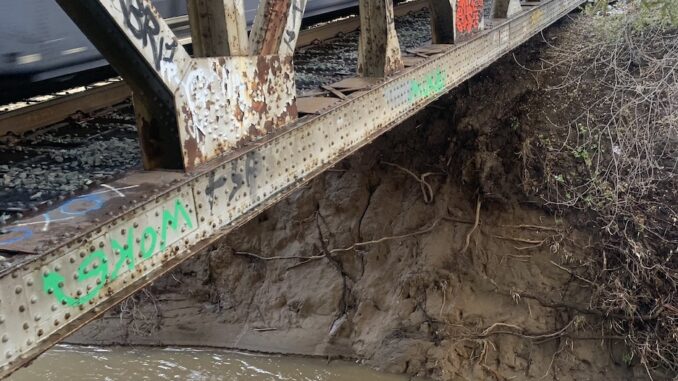
BY BRADEN CARTWRIGHT
Daily Post Staff Writer
A badly eroded creek bank that holds up a train bridge between Palo Alto and Menlo Park will have to survive another winter.
That’s because Caltrain will miss the deadline to do construction in the creek before the rainy season begins, project manager Mike Boomsma said yesterday.
Soil that holds up the northern side of the bridge was washed away on New Year’s Eve, when water in the San Francisquito Creek reached historic heights and speeds.
The soil bank was “severely scoured and undermined to a near vertical condition,” said Rob Barnard, Caltrain’s deputy chief of design and construction.
The bank will continue to erode and become unstable unless Caltrain acts, Barnard told his board in March.
The Alma Street bicycle bridge faces the same threat, he said.
Caltrain’s board declared an emergency to fast-track the repair but couldn’t get the permits between June 15 and Oct. 15, when construction is allowed in the creek, Barnard said.
Caltrain spokesman Dan Lieberman has maintained that the project was on track, up until today (Oct. 2), when Barnard’s report was released ahead of Caltrain’s Thursday board meeting.
Caltrain employees will monitor the bridge’s foundations throughout the winter and put in a “temporary stabilization system” if necessary, Barnard said in his report.
Caltrain hired a contractor, budgeted $6.5 million and signed agreements with Menlo Park and Palo Alto. Crews were ready to put in soil, fabric, boulders and plants to make the slope less steep and more secure.
But the U.S. Army Corps of Engineers required Caltrain to get approval from a state historic preservation officer, which wasn’t possible before the dry season ended, Barnard said.
The bridge is right next to El Palo Alto, a 1,000-year-old redwood tree that is a symbol of Stanford and the city of Palo Alto. A concrete wall on the southern bank protects the tree’s roots.
When Caltrain declared an emergency in March, Palo Alto Councilman Pat Burt was worried that a repair on the north side would speed up erosion on the south side.
“It could get overlooked and have dire consequences,” he said.
